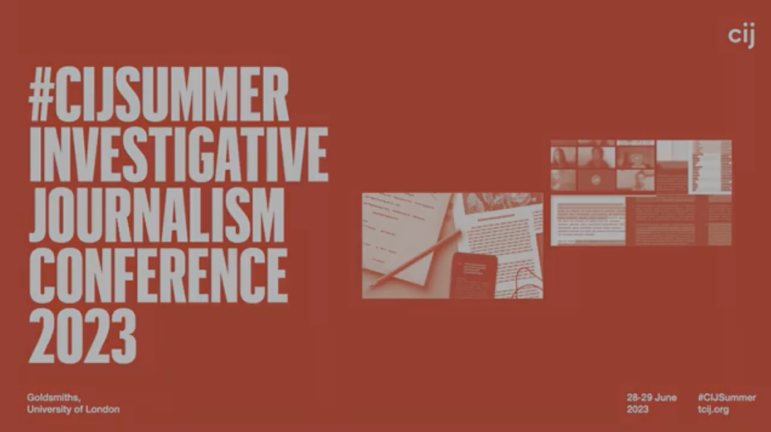

Mastering the Rollout: Increasing the Impact of Your Investigative Story
Read this article in
In November 2022, George Santos was elected to the US Congress to represent New York’s 3rd District. But almost as soon as the race was called, journalists began unraveling an epic tapestry of his lies about his employment, financial, education, and religious background. And while these exposés have now triggered several state and federal investigations into the congressman, the volume and absurdity of his lies raised another, broader question: How did everyone in the press miss this?
In fact, not everyone did.
Before large legacy outlets such as The New York Times, The Washington Post, and The Atlantic uncovered Santos’ prolific misrepresentations, one small, local newspaper, the North Shore Leader, had dug into the candidate’s background and documented numerous irregularities and outright false claims.
So why didn’t these revelations ignite a national media firestorm and prompt local party officials to call for him to step down (as they have now)? The answer offers a cautionary tale for every journalist who longs for greater impact of their reporting but struggles with how to promote and market it.

A small New York newspaper uncovered suspicious claims by a US Congressional candidate, but they failed to get noticed before he was elected. Image: Screenshot, North Shore Leader
The Leader’s findings on Santos, it turns out, were never shared on Facebook or Instagram, nor did the newspaper Tweet about it. In fairness, the small outlet, which only has a circulation of roughly 20,000, does not have a Twitter account or even a person to run their social media platforms. As a result, this vital information was unable to break through to a wider audience in time to inform voters before the election.
The takeaway for newsrooms? Succeeding in today’s cluttered media landscape requires more than merely powerful journalism — it also requires both building an audience for it and successfully disseminating information in innovative ways.
In this piece, GIJN speaks with leaders in audience engagement and masters of story promotion at nonprofit outlets globally to share best practices to avoid one of journalism’s deadliest sins: great investigative reporting that no one notices.
Meeting Audiences Where They Are
There are many steps to producing an investigative story or series. From the initial kernel of an idea to the resulting 4,000-word piece, the majority of focus is typically spent on research, fact-checking, writing, and of course, making sure content is accurate and ready for publishing. But, according to ProPublica’s Director of Audience Strategy, Dan Petty, there are two other key factors newsrooms need to scrutinize before launch: headlines and search engine optimization (SEO).
“We hired a search engine optimization specialist, with considerable experience in building brands and as a result, we are really leaning into producing sort of ancillary search-driven content to go along with our investigations,” Petty explains.
By producing complementary content, such as an explainer that answers questions relevant to the investigation, or offers background on how the investigation was built, Petty says the ProPublica team offers a more robust meal for viewers to consume that can extend and amplify impact — with an eye for what will attract readers.
This type of complementary content can come in many forms and quality media have done versions of this for years. Follow-up pieces that go “Behind the Story,” or offer “How We Did It” explainers can often be constructed using what already lives on the cutting room floor of an edited investigation. These stories can also zoom in on one facet of an investigation.
One example: a November 2022 ProPublica investigation into how title lending can trap Americans in a vicious debt cycle. By conducting SEO research, Petty and his team realized a significant number of people search for the term “title lending.” As a result, ProPublica produced a separate piece to tap into this audience: How Title Lending Works.

As part of its rollout for an investigative piece on title lending, ProPublica created a separate “explainer” to bring in more readers generally searching online about the topic. Image: Screenshot, ProPublica
This engagement strategy reasons that some people might see the investigation organically, but it is more likely that someone might be searching for “title lending” and then click through from their explainer to the exposé. These spin-off stories allow venues to meet readers where they are — on their own search terms and timing — to convert more people and build a more diverse readership.
Matt Adams, NPR’s Acting Supervisor of Audience Engagement, shares Petty’s sentiment, but takes a more visual approach. Using tools such as Facebook gallery, the NPR team has had success sharing interesting facts, catchy quotes, and striking imagery to complement its reporting. Image-editing service Canva, which offers both free and paid plans, allows anyone, regardless of their design background, to create engaging media content with both free and paid templates and images.
The NPR team also occasionally takes the idea of the written “explainer” piece but instead creates a visual narration using cartoons or comics.

For a story on how to safely intervene when you see someone being harassed or attacked, NPR created a set of graphic cards on Facebook to help increase engagement on social media. Image: Screenshot, NPR
Similarly, sometimes certain stories lend themselves to particular audiences or specific social media platforms. One obvious example was German nonprofit CORRECTIV’s investigation, “Kein Filter für Rechts” (in English, “No Filter for the Right”). This piece focused on how right-wing recruiters in Germany are using Instagram to attract young people.
Since the team already knew where their audience was, Till Eckert, investigative reporter at CORRECTIV, said he and his team made sure to make Instagram the centerpiece of their story promotion. They also took time to identify potential Instagram influencers and encourage them to share the piece. The results? The Instagram posts for this campaign averaged roughly 6,000 likes, about two to four times more than the average for a typical CORRECTIV post.
“You can apply this strategy for every platform, for every single investigation that you do,” Eckert says. “Writing something about the Amazon? Check out all of the Amazon touch points — climate influencers, those who spend all day talking about nothing else.”
But, be sure to come prepared. Eckert says influencers and other collaborators are more willing to help when you come to them with pre-packaged text or visual content, making it easy for them to connect their audiences with your work.

German investigative site CORRECTIV created a set of images specifically for Instagram to increase audience engagement about its look into far right recruitment on social media. Image: Screenshot, CORRECTIV
Experiment with Old and New Platforms
When it comes to social media selection, a bit of experimentation and thinking “big picture” is also necessary. “Figuring out your goal for the story is really important,” Adams explains. From here, a team needs to determine how this interaction advances their goals.
For example, will a fact-filled Twitter thread sequence pack a punch with your intended audience, or, at the very least, provide key takeaways? Or would your audience respond best to a visual experience, like graphics or video? The answers to these questions are not easy, and often do not come without trial and error.
If you have a small social media or marketing team (or none at all), Adams suggests looking first at where your audience is interacting the most before proceeding. Then you can experiment with creating differing types of campaigns to drive engagement. Later, you can take the time to see how other platforms can evolve, too.
He also suggests stepping out of the typical journalistic community online to tap into new possible audiences. In the past, Adams’ team has experimented with platforms such as Reddit and Twitter Spaces to promote stories, including a Q&A with one of their journalists. On these platforms, the NPR team’s goals were not solely to bring in more clicks, but to instead build their brand on a new channel with diverse people.
Experimenting with new platforms can also be a pathway to reaching novel, and often younger audiences. In a recent interview, Johanna Rüdiger, the Head of Social Media for Deutsche Welle, shared DW’s strategy for one of their nine different TikTok accounts.
“We dedicate a lot of attention to the first sentence we use to kick off the video. We work very hard on that first sentence because we want to grab people’s attention in the first two seconds of each video and tell them right away what the value of the video is,” Rüdiger said.
Rüdiger and her team have approached serious topics on this channel, partnering with the Concentration Camp Memorial Neuengamme, for a seven-part explainer series. One of these videos became their most-watched TikTok ever — and also went viral on Instagram, Facebook, and YouTube, proving this video format worked on a variety of social platforms. As a result, Rüdiger said DW accomplished its two-pronged goal: Messaging a serious topic in a short-form video, and reaching and informing young people, as most of the video’s viewers were under 24 years old.
Step-by-Step Rollout Plan
Anastasiia Borema is head of social media for Bihus.Info, a popular Ukrainian investigative site focusing on uncovering corruption. Prior to publication of a story, she and her small staff discuss a number of packaging and outreach tactics. Although these steps vary depending on the specific investigation, she says her site’s marketing plan usually follows a timeline like this:
- Sneak preview video announcement or behind-the-scenes photos.
- Preparation of high-quality preview texts including eye-grabbing header for social networks.
- Formating Instagram carousels, short videos for social networks, infographics, etc.
- Distribution of these pre-prepared social media texts, visuals, and the investigation among relevant groups and partners prior to launch or immediately following launch for collaborations.
- After publication, publicize and share a livestream where readers can ask questions of the investigation’s journalists.
- Following these livestreams, create content/posts about interesting moments during these live Q & As to further engage audiences online.
After all these steps, her team studies the analytics to draw conclusions about what worked. These key metrics include pageviews and time on page on YouTube; reach, interaction, and engagement rate on Facebook; reach, distribution, retention and interaction on Instagram; and views and likes on Tik Tok. Her team also measures the growth of subscribers and followers after each campaign.
Depending on your specific organization, your social media strategy may vary. However, following the basic structures of her plan — or planning to have a social media plan in general is a good start. Here are some templates to help you get started.
Overcoming Unique Obstacles
Unfortunately, it is not always easy to find or meet your audiences where they are, especially when your organization is based in a region or country that limits media freedom, or worse, is exiled and your content faces targeted censorship.
Armando.Info has found creative ways to not only survive in exile outside its home country of Venezuela, but also thrive using satire.

Armando.Info has partnered with a Miami-based company to create satirical Tweets that allow its investigations to avoid censorship in its native Venezuela. Image: Screenshot, Twitter
Due to their critical reporting, some of the links to Armando.Info’s website are blocked within Venezuela. In response, Ewald Scharfenberg, co-founder of Armando.info, started a collaboration with Juan Andrés Ravell, the director of Plop, a Miami-based production company, which functions in a style similar to that of parody site The Onion in the US.
“The idea was to produce animated Twitter threads with a humorous tone to preview the report,” Ravell explains. Of course, blending any form of humor with serious investigative work poses risks. “With this kind of project we are trying to make investigative journalism more edible, more friendly,” he says. “We are very aware that we cannot betray the journalistic basis of the work, and we are very, very aware in every stage of the process that we cannot distort the journalism itself.”
Using this kind of tactic, Armando.info’s satirical Twitter thread can puncture the country’s veil of censorship and alert readers to the investigation — sometimes accruing higher viewing numbers than the story itself. For example, Scharfenberg says a typical Armando.Info investigation gets around 30,000 readers, but their satirical Twitter threads garner an average of 300,000, with many readers who are under 30 years of age.
Measuring Success
Success can sometimes be hard to define and can vary from site to site and even from story to story. For example, you might make gains in increasing your social media following, but this might not translate into more clicks on a specific story. So, taking a broader perspective on your marketing and rollout efforts is advisable.
But if you’ve already set clear objectives and spent the time to create a solid promotion plan, you likely already have the information you need to determine your campaign’s success.
More Best Practices
- Be patient. Experimentation on social media takes time and resilience. Test out different tactics to see what works best for your audience. Try a sneak preview in your newsletter to build buzz for an upcoming investigation. Release a behind-the-scenes explainer piece and promote this piece alongside your investigation. Try, tweak, and try some more.
- Study the wins and losses. Did your campaign rake in 1,000 new followers? Or did it have really low engagement? Always examine the ‘why’ behind both social media success and failure, in order to inform your next campaign.
- Focus on both qualitative and quantitative results. Engagement and clickthrough rates are great quantitative metrics on which to base success, but they are not the only forms of achievement. Did your investigation end up being included in a newsletter with a large following? Did you receive more emails than average with feedback on your investigation? Did a politician amplify or respond to your Tweet about the investigation and promise action? These are all qualitative wins that also contribute to success.
- Set tangible goals. If you have a following of 100 people on Instagram and typically gain one or two followers a month, don’t expect to boost your followers by 500 people after one investigation. Instead, set realistic benchmarks that you know can be achieved based on your current metrics and followership.
Additional Resources
12 Tips on Reaching More People and Getting Bigger Impact on Investigative Stories
The Case for Investing in Audience Engagement
Gauging the Impact of Your Journalism
 Holly Pate is GIJN’s Social Media Editor. Previously, she was the Social Media and Outreach Director of The Outlaw Ocean Project, a non-profit journalism project. She has written for venues including The New York Times and The Capital News Service.
Holly Pate is GIJN’s Social Media Editor. Previously, she was the Social Media and Outreach Director of The Outlaw Ocean Project, a non-profit journalism project. She has written for venues including The New York Times and The Capital News Service.









